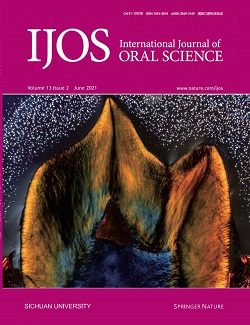形成牙齿的预先指定的牙间质细胞。
IF 12.2
1区 医学
Q1 DENTISTRY, ORAL SURGERY & MEDICINE
引用次数: 0
摘要
位置信息在胚胎模式的形成中起着至关重要的作用,但其在牙齿发育中的作用仍未被探索。在本研究中,我们研究了牙齿发育过程中舌牙和颊牙间质的区域特征。从小鼠下颌骨中分离牙帽期的牙胚,分离其舌部和颊部间充质区,进行大量RNA测序。基因本体论分析显示,牙体形成、模式规范和增殖相关基因在舌间质富集,而干细胞发育、间质分化、神经嵴分化和再生相关基因在颊间质中占主导地位。Wnt1creERT/+重组实验;R26RtdT/+和WT小鼠模型表明,舌间质参与牙齿形成,而颊间质主要支持周围组织。此外,在体外培养和肾包膜下移植时,只有舌部的牙胚表现出成牙潜能。大量RNA转录组分析进一步证实了舌和颊间质的区域特征。这些发现为牙齿发育和模式形成过程中位置信息的分子基础提供了新的见解。本文章由计算机程序翻译,如有差异,请以英文原文为准。
Prespecified dental mesenchymal cells for the making of a tooth.
Positional information plays a crucial role in embryonic pattern formation, yet its role in tooth development remains unexplored. In this study, we investigated the regional specification of lingual and buccal dental mesenchyme during tooth development. Tooth germs at the cap stage were dissected from mouse mandibles, and their lingual and buccal mesenchymal regions were separated for bulk RNA sequencing. Gene ontology analysis revealed that odontogenesis, pattern specification, and proliferation-related genes were enriched in the lingual mesenchyme, whereas stem cell development, mesenchymal differentiation, neural crest differentiation, and regeneration-related genes were predominant in the buccal mesenchyme. Reaggregation experiments using Wnt1creERT/+; R26RtdT/+ and WT mouse models demonstrated that lingual mesenchyme contributes to tooth formation, while buccal mesenchyme primarily supports surrounding tissues. Furthermore, only the lingual part of tooth germs exhibited odontogenic potential when cultured in vitro and transplanted under the kidney capsule. Bulk RNA transcriptomic analysis further validated the regional specification of the lingual and buccal mesenchyme. These findings provide novel insights into the molecular basis of positional information in tooth development and pattern formation.
求助全文
通过发布文献求助,成功后即可免费获取论文全文。
去求助
来源期刊

International Journal of Oral Science
DENTISTRY, ORAL SURGERY & MEDICINE-
CiteScore
31.80
自引率
1.30%
发文量
53
审稿时长
>12 weeks
期刊介绍:
The International Journal of Oral Science covers various aspects of oral science and interdisciplinary fields, encompassing basic, applied, and clinical research. Topics include, but are not limited to:
Oral microbiology
Oral and maxillofacial oncology
Cariology
Oral inflammation and infection
Dental stem cells and regenerative medicine
Craniofacial surgery
Dental material
Oral biomechanics
Oral, dental, and maxillofacial genetic and developmental diseases
Craniofacial bone research
Craniofacial-related biomaterials
Temporomandibular joint disorder and osteoarthritis
The journal publishes peer-reviewed Articles presenting new research results and Review Articles offering concise summaries of specific areas in oral science.
 求助内容:
求助内容: 应助结果提醒方式:
应助结果提醒方式:


